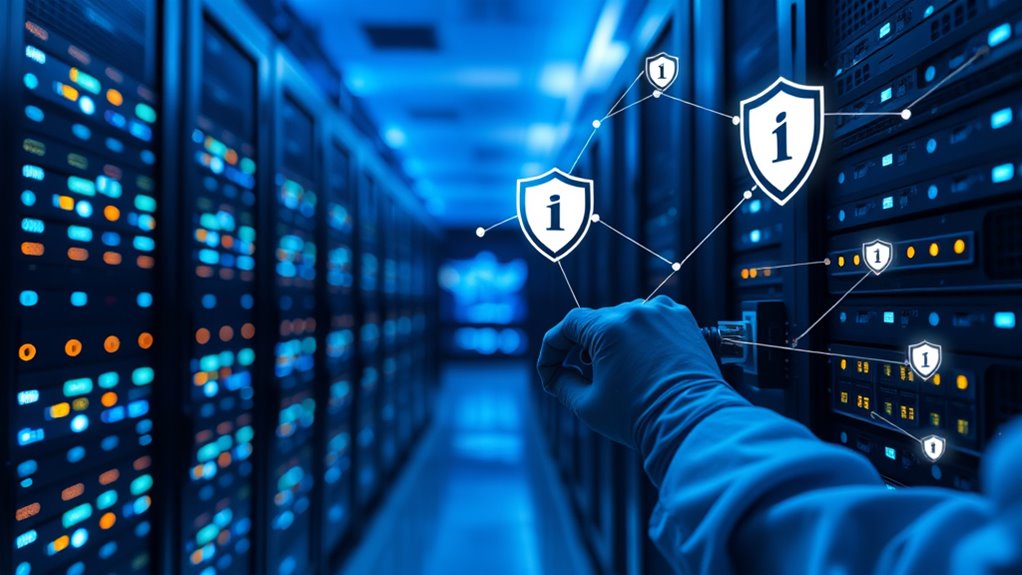To mitigate third-party library risks in your CI pipelines, you should implement dependency scanning and security checks to identify vulnerabilities before release. Automate license compliance reviews to catch restrictive or incompatible licenses early. Continuously monitor dependencies for updates and vulnerabilities, and set pipelines to halt on issues. Combining these practices creates a secure, compliant environment that boosts your confidence in releases—continue exploring how to strengthen your CI process further.
Key Takeaways
- Implement automated dependency scanning to identify outdated, vulnerable, or malicious third-party libraries before integration.
- Enforce license compliance checks to detect and address incompatible or restrictive licenses early in the CI process.
- Integrate security and license audits into CI pipelines for real-time feedback and immediate issue resolution.
- Regularly monitor dependencies for security vulnerabilities and updates to minimize risk exposure over time.
- Use trusted repositories and version control to ensure consistent, secure, and compliant third-party library usage.

In modern continuous integration (CI) pipelines, third-party libraries play a crucial role in accelerating development and guaranteeing feature-rich applications. However, integrating external code introduces risks that can compromise security, stability, and legal compliance. To address these challenges, it’s necessary to implement robust processes like dependency scanning and license compliance checks. Dependency scanning helps you identify all third-party components used in your codebase, revealing outdated, vulnerable, or malicious libraries before they make it into your release. By continuously monitoring dependencies, you can promptly flag security issues, such as known vulnerabilities, and address them proactively, reducing the attack surface of your application. This process guarantees that only trusted and secure libraries are incorporated, minimizing the risk of exploitation. Increased awareness of security best practices among developers further enhances your overall risk mitigation strategy.
Implement dependency scanning to identify vulnerabilities and ensure only trusted libraries enter your CI pipeline.
Simultaneously, maintaining license compliance is crucial to avoid legal liabilities. Many third-party libraries come with licenses that impose restrictions on usage, distribution, or modification, and overlooking these can lead to costly disputes or damage your reputation. Implementing license scanning tools within your CI pipeline allows you to automatically audit dependencies against licensing requirements. This way, you can detect incompatible licenses early, prevent non-compliant libraries from progressing through your deployment pipeline, and maintain transparency with stakeholders. By guaranteeing license conformity, you protect your organization from legal consequences and uphold ethical standards.
Together, dependency scanning and license compliance form the backbone of a secure and lawful CI process. You can automate these checks to run with every build, providing real-time insights and immediate feedback. When a vulnerability is detected or a license conflict arises, your pipeline can halt the process, prompting you to investigate and resolve issues before they escalate. This proactive approach not only fortifies your application but also streamlines compliance workflows, saving time and resources in the long run. Furthermore, integrating these practices encourages a culture of accountability and awareness among your development team, emphasizing the importance of security and legal adherence from the outset.
Incorporating dependency scanning and license compliance tools into your CI pipeline creates a resilient development environment. It helps you catch potential risks early, maintain legal integrity, and deliver safe, compliant software products. By making these checks an automated part of your workflow, you reduce manual errors, improve efficiency, and foster confidence in your releases—guaranteeing that your application remains robust and trustworthy in a landscape fraught with evolving threats and regulatory demands.
Frequently Asked Questions
How Can I Detect Malicious Code in Third-Party Libraries?
To detect malicious code in third-party libraries, you should focus on maintaining code integrity and verifying sources. Always check the library’s origin, reviews, and reputation before integrating it. Use digital signatures or checksum verification to guarantee files haven’t been tampered with. Regularly scan libraries with security tools, monitor for unusual behaviors, and stay updated on known vulnerabilities. These steps help you catch malicious code early and protect your project.
What Are the Best Tools for Automated Library Vulnerability Scanning?
You should consider using dependency management tools like Snyk, Dependabot, or OWASP Dependency-Check for automated vulnerability detection. These tools scan your libraries regularly, identify known vulnerabilities, and generate alerts so you can act swiftly. They integrate seamlessly into your CI pipelines, ensuring continuous monitoring. By automating vulnerability scans, you minimize risks and keep your codebase secure without manual effort, making your development process safer and more efficient.
How Often Should I Update Third-Party Dependencies in CI Pipelines?
Imagine your project is a garden that needs regular watering. You should update third-party dependencies in your CI pipelines frequently enough to keep it healthy, but not so often that it gets overwhelmed. Aim for a consistent update schedule—such as weekly or bi-weekly—to maintain dependency freshness and reduce vulnerabilities. Regular updates guarantee you’re protected against known issues while avoiding unnecessary disruptions or compatibility problems.
What Are the Legal Implications of Using Third-Party Libraries?
When using third-party libraries, you need to stay aware of legal implications around license compliance and intellectual property rights. You could face legal action if you ignore licensing terms, such as attribution or usage restrictions. Always review licenses carefully, confirm your use aligns with their requirements, and keep documentation updated. This vigilance helps protect your project from potential legal disputes and ensures you’re respecting the intellectual property rights of library owners.
How Do I Manage Dependencies Across Multiple Projects Securely?
Imagine you’re the captain of a ship steering treacherous waters—dependency management is your lighthouse. To manage dependencies securely across multiple projects, you should implement consistent version control, automate license compliance checks, and use centralized package registries. Regularly audit dependencies for vulnerabilities, and enforce policies to avoid outdated or risky libraries. This proactive approach helps keep your projects safe, compliant, and running smoothly, avoiding legal or security storms ahead.
Conclusion
By implementing these best practices, you can confidently manage third-party library risks in your CI pipelines. Some might think it’s too time-consuming, but the upfront effort saves you from costly security breaches later. With proper checks and automation, you’ll guarantee your pipeline remains secure without slowing down development. Trust that proactive measures today protect your projects and reputation tomorrow—making your CI process both efficient and resilient.









